Recent Posts
The Hidden Dangers of Water Damage and Why Immediate Action Matters
3/11/2025 (Permalink)
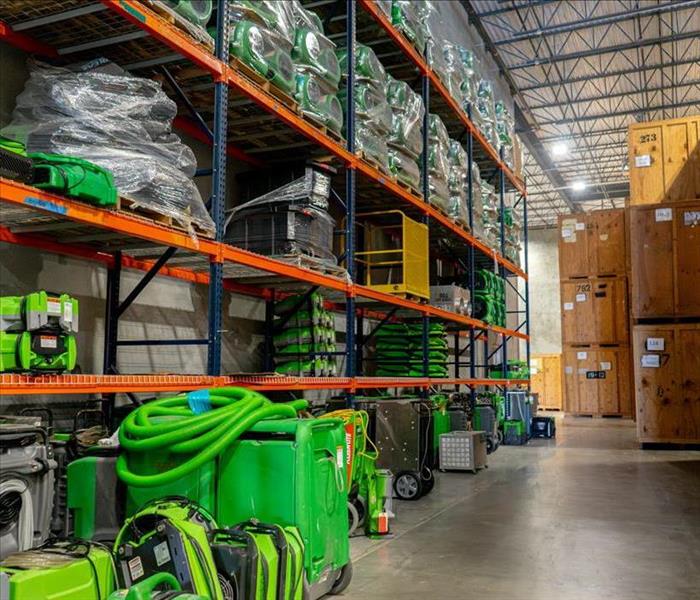 Equipment warehouse located in Greater Houston
Equipment warehouse located in Greater Houston
Water damage is one of the most common disasters that homeowners and businesses face. Whether caused by a burst pipe, severe weather, or a hidden plumbing leak, even a small amount of water can lead to significant damage if not addressed quickly. SERVPRO® of Baytown/Channelview specializes in professional water damage restoration, ensuring that properties are properly dried and restored to prevent further issues.
How Water Damage Affects Your Property
Water damage isn’t always immediately visible, but it can lead to serious long-term problems, including:
- Structural Damage: Water can weaken drywall, flooring, and even the foundation of a building if left unchecked.
- Mold Growth: Excess moisture creates the perfect environment for mold, which can spread in as little as 24 to 48 hours.
- Electrical Hazards: Water intrusion near electrical wiring or outlets can create fire risks and power failures.
- Damage to Personal Belongings: Furniture, documents, and electronics can all be permanently damaged by prolonged exposure to moisture.
What to Do When Water Damage Occurs
- Shut Off the Water Source – If the damage is due to a plumbing issue, turn off the main water supply to prevent further flooding.
- Turn Off Electricity in Affected Areas – Water and electricity are a dangerous combination. If water is near electrical outlets or appliances, turn off the power to that area.
- Remove Excess Water if Safe to Do So – Use towels, mops, or a wet/dry vacuum to remove standing water, but avoid contact with contaminated water.
- Document the Damage – Take photos and make a list of damaged items for your insurance claim.
- Call SERVPRO® of Baytown/Channelview for Professional Restoration – Our team responds quickly to extract water, dry affected areas, and restore your property to its pre-damage condition.
Why Choose SERVPRO® of Baytown/Channelview?
- 24/7 Emergency Service – Water damage can worsen quickly, so we respond immediately to mitigate further issues.
- Advanced Drying and Moisture Detection Equipment – We use state-of-the-art tools to ensure all moisture is removed, even in hard-to-reach areas.
- Comprehensive Restoration – From water removal to repairs, we handle every step of the restoration process.
- Insurance Coordination – We work directly with your insurance company to make the claims process easier for you.
Water damage should never be ignored. If your home or business has been affected, contact SERVPRO® of Baytown/Channelview for expert water damage restoration services.
The Dangers of Smoke and Soot After a Fire and How to Restore Your Property
3/11/2025 (Permalink)
 Team Shaw technicians
Team Shaw technicians
A fire can cause devastating damage to a home or business, but even after the flames are extinguished, lingering smoke and soot can create long-term issues. Many property owners assume that once the fire is out, the danger is over—but the reality is that smoke damage can continue to affect air quality, surfaces, and personal belongings if not properly addressed. SERVPRO® of Baytown/Channelview specializes in professional fire damage restoration, ensuring that homes and businesses are restored quickly and safely.
How Smoke and Soot Damage Your Property
- Smoke Residue Can Spread Quickly: Smoke travels through ventilation systems and can settle on walls, ceilings, and furniture, even in rooms unaffected by flames.
- Soot is Highly Acidic: If left untreated, soot can permanently damage walls, glass, electronics, and metal surfaces.
- Smoke Odors Linger: Without professional deodorization, smoke smells can become trapped in carpets, drapes, and upholstery for months.
- Health Risks: Inhaling smoke particles can cause respiratory issues, especially for children, the elderly, and those with pre-existing conditions.
What to Do After a Fire
- Ensure Safety First – Wait for fire officials to confirm that it is safe to enter your property.
- Avoid Touching Soot-Covered Surfaces – Improper cleaning can cause soot to spread or stain permanently.
- Open Windows for Ventilation – If safe, allow fresh air to circulate and reduce smoke odors.
- Document the Damage – Take photos for insurance claims before any cleaning or restoration begins.
- Call SERVPRO® of Baytown/Channelview for Fire Damage Restoration – Our team will remove soot, eliminate odors, and restore your property quickly.
How SERVPRO® of Baytown/Channelview Can Help
- Smoke and Soot Removal: We use advanced cleaning techniques to remove residue from walls, ceilings, and surfaces.
- Odor Elimination: Our deodorization process removes smoke odors from the air and porous materials.
- Structural Repairs: From minor repairs to full home reconstruction, we restore fire-damaged properties.
- Insurance Coordination: We assist with insurance claims to simplify the restoration process.
If your home or business has been affected by a fire, don’t wait—contact SERVPRO® of Baytown/Channelview for professional fire damage restoration.
Why Businesses in Baytown and Channelview Need Professional Cleaning and Restoration Services
3/11/2025 (Permalink)
 Main HQ office and admin crew
Main HQ office and admin crew
Owning a business comes with many responsibilities, and maintaining a clean, safe environment is essential for employees and customers. From daily wear and tear to unexpected disasters like water damage or fire incidents, commercial properties require professional cleaning and restoration services. SERVPRO® of Baytown/Channelview offers specialized solutions to keep businesses operating smoothly.
Common Commercial Property Challenges
- Heavy Foot Traffic: Offices, retail stores, and restaurants experience constant foot traffic, leading to dirt buildup and floor damage.
- Water Leaks and Flooding: Plumbing failures, roof leaks, and storm damage can disrupt business operations and cause costly repairs.
- Fire and Smoke Damage: Even a small fire can create lingering smoke odors and require extensive cleanup.
- Mold and Indoor Air Quality Issues: Poor ventilation and high humidity can contribute to mold growth, affecting air quality and employee health.
SERVPRO® Commercial Services
- Deep Cleaning: Our commercial cleaning services include carpet cleaning, tile and grout cleaning, and HVAC system maintenance.
- Water and Fire Damage Restoration: We respond quickly to emergencies, ensuring minimal downtime for businesses.
- Mold Remediation: Our experts identify, remove, and prevent mold growth in commercial buildings.
- Biohazard and Disinfection Services: We provide professional sanitization services for healthcare facilities, offices, and industrial spaces.
Why Choose SERVPRO® of Baytown/Channelview for Commercial Cleaning and Restoration?
- 24/7 Emergency Response: Disasters don’t wait, and neither do we. Our team is available around the clock.
- Minimized Business Disruptions: We work efficiently to get businesses back to normal as quickly as possible.
- Customized Cleaning Plans: We tailor our services to meet the unique needs of each business.
- Insurance Assistance: We coordinate with insurance providers to simplify claims and reduce downtime.
For reliable commercial cleaning and restoration services in Baytown and Channelview, trust SERVPRO® of Baytown/Channelview. Contact us today to schedule a consultation or emergency service.
Spotting Storm Damage: A Guide to Recognizing Property Damage After a Storm
1/16/2024 (Permalink)
 When nature strikes, it often leaves behind a trail of destruction that requires immediate attention.
When nature strikes, it often leaves behind a trail of destruction that requires immediate attention.
When nature strikes, it often leaves behind a trail of destruction that requires immediate attention. Identifying storm damage is crucial to kick-starting the restoration process efficiently. In this blog, we'll walk you through the essential steps to recognize storm damage on your property.
Understanding the Types of Storm Damage
- Roof Damage
Winds, hail, or fallen debris during storms can severely impact your roof. Look for missing shingles, cracks, dents, or water stains in your attic or ceiling.
- Structural Damage
High winds can weaken the structure of your property, causing cracks in walls, foundations, or even structural warping.
- Water Damage
Heavy rains or flooding can lead to water intrusion, causing damage to walls, floors, and belongings. Check for signs of water stains, mold, or musty odors.
- Tree Damage
Fallen trees or branches can cause significant damage to your property. Inspect for broken windows, structural damage, or debris scattered around the area.
Steps to Identify Storm Damage
Safety First: Before assessing damage, prioritize safety. Check for any immediate hazards, such as downed power lines or unstable structures.
Exterior Inspection: Walk around your property to spot any visible signs of damage. Look for dents, cracks, missing materials, or displaced items.
Roof Inspection: Inspect your roof for missing or damaged shingles, dents, or holes. Use binoculars for a closer look if climbing onto the roof isn’t safe.
Interior Assessment: Check ceilings, walls, and floors for water stains, leaks, or any visible signs of damage.
Professional Inspection: For a thorough evaluation, contact a trusted restoration company like SERVPRO of Baytown/Channelview. Our experts have the tools and expertise to assess hidden damages accurately.
Why Immediate Action is Essential
Ignoring storm damage can lead to more significant issues down the line, such as mold growth, structural weakening, or increased repair costs. Taking prompt action not only ensures your safety but also prevents secondary damage.
How SERVPRO® Can Help
At SERVPRO of Baytown/Channelview, we understand the urgency of storm damage restoration. Our trained technicians promptly respond to assess and mitigate damages. Using advanced equipment and proven techniques, we restore your property to its pre-damaged condition efficiently.
Identifying storm damage early is crucial for a swift and effective restoration process. Regular inspections and immediate action can minimize the impact and costs associated with such damages. Remember, your safety is paramount.
Stay safe, stay prepared!
Restoring Your Home: The Step-by-Step Process of Fire Damage Cleanup
12/15/2023 (Permalink)
Fires can be devastating, but with a well-structured approach, your home can be restored to its former glory. In this blog, we'll walk you through the essential steps of fire damage cleanup, helping you understand what to expect during this challenging time.
Step 1: Assessment and Inspection
The first crucial step in the fire damage cleanup process is the initial assessment. Our professionals will evaluate the extent of the damage, noting structural issues, the presence of hazardous materials, and the severity of soot and smoke residue. This assessment guides the development of a customized restoration plan.
Step 2: Safety Measures
Safety is a top priority in any fire damage cleanup. Our team will secure the area, addressing potential safety hazards like weakened structures, electrical problems, and harmful materials. We ensure that your property is safe for both our team and your family.
Step 3: Water Removal
Fires are often extinguished with water or other suppressants, which can lead to secondary damage. We'll remove any standing water, thoroughly dry the affected areas, and prevent mold growth.
Step 4: Soot and Smoke Removal
Soot and smoke residue can be challenging to remove and can cause long-term damage if left untreated. Our team uses specialized equipment and cleaning agents to remove these contaminants from walls, ceilings, and surfaces.
Step 5: Odor Elimination
The lingering smoke odor is a common issue after a fire. We employ advanced deodorization techniques, including ozone treatments and thermal fogging, to completely eliminate these odors and ensure your home smells fresh again.
Step 6: Cleaning and Sanitizing
All salvageable items and structures are meticulously cleaned and sanitized. We use industry-leading cleaning solutions to restore your belongings to their pre-fire condition.
Step 7: Repairs and Restoration
Once the cleaning is complete, the restoration process begins. This involves structural repairs, such as replacing drywall and flooring, painting, and other finishing touches. Our goal is to return your home to its pre-fire condition, "Like it never even happened."
Step 8: Content Restoration
In addition to your home's structure, we also address the restoration of personal belongings and furnishings. Our professionals will assess and restore items as needed, ensuring you retain as much as possible.
Step 9: Final Inspection
After completing the restoration work, a final inspection is conducted to ensure that every aspect of your home has been restored to its pre-fire state.
Step 10: Documentation and Insurance
We provide comprehensive documentation of the restoration process, which is essential for insurance claims. Our team works closely with your insurance company to facilitate a smooth claims process.
Fire damage cleanup is a complex and detailed process that requires expertise and experience. At SERVPRO® of Baytown/Channelview, we understand the importance of a thorough and systematic approach to fire damage restoration. Our goal is to bring your home back to its pre-fire condition, ensuring your peace of mind during this challenging time. If you've experienced a fire and need professional assistance with cleanup and restoration, don't hesitate to contact our local SERVPRO® team today. We're here to help you through every step of the process and restore your home to its former glory!
9 Tips for Cleaning Small Mold Infestations in Your Home
11/10/2023 (Permalink)
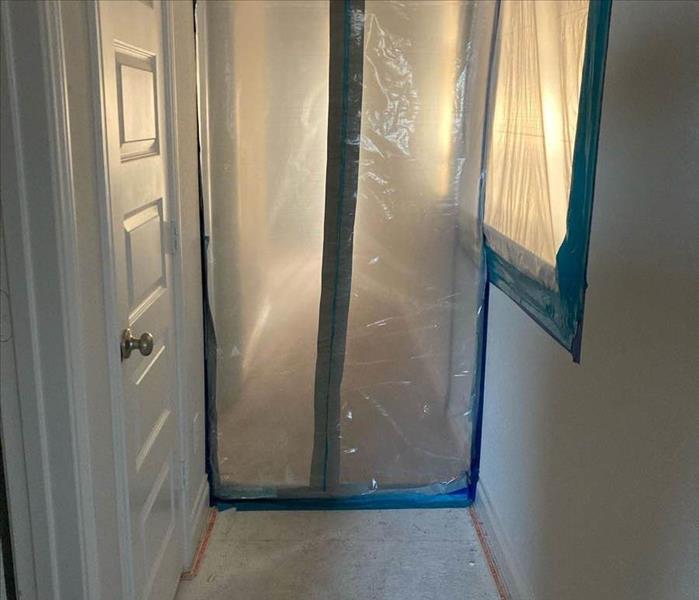 if you encounter extensive mold issues, it's best to consult with professionals like SERVPRO® of Baytown/Channelview for thorough mold remediation.
if you encounter extensive mold issues, it's best to consult with professionals like SERVPRO® of Baytown/Channelview for thorough mold remediation.
Dealing with mold can be a common issue, especially in humid climates like Baytown, TX. Knowing how to handle small mold infestations is essential to maintain a clean and mold-free living environment. In this blog, we'll guide you through the steps to effectively clean up small amounts of mold in your Baytown home. By taking the right measures, you can ensure the safety of your property and your loved ones.
Safety First
Before embarking on any mold cleanup, prioritize your safety. Mold spores can be risky, so it's crucial to wear appropriate personal protective equipment (PPE). Equip yourself with gloves, goggles, and a mask to protect against exposure to mold.
Identify the Mold
Start by identifying the type of mold you're dealing with. While most molds are harmless, some may require special precautions. Common molds found in homes include Cladosporium, Penicillium, and Aspergillus. Identifying the mold type can help determine the best cleaning approach.
Gather Your Supplies
To effectively clean up mold, you'll need several supplies on hand, including:
- Protective gear (gloves, goggles, mask)
- Plastic sheets or tarps to contain the affected area
- A scrub brush, detergent, and water for cleaning
- Hydrogen peroxide or white vinegar for disinfection
- Plastic bags for disposing of contaminated materials
- A HEPA vacuum cleaner to capture mold spores
- Fans and dehumidifiers to aid in drying the area
Contain the Area
To prevent mold spores from spreading to other parts of your home, isolate the mold-infested area. Seal it off with plastic sheets or tarps, ensuring proper ventilation by directing airflow outside. This containment step is crucial in limiting the mold's spread and reach during cleanup.
Clean the Mold
Begin cleaning by gently scrubbing the moldy surface with a scrub brush and a mixture of detergent and water. This step helps remove the mold from non-porous surfaces. Rinse the area thoroughly with clean water and allow it to dry completely. Adequate drying is essential to discourage future mold growth.
Disinfect the Area
To prevent mold from returning, it's vital to disinfect the cleaned area. Hydrogen peroxide or white vinegar can be effective natural solutions for this purpose. These substances can help kill any remaining mold spores, adding an extra layer of protection against mold recurrence.
Vacuum with a HEPA Filter
Use a vacuum cleaner equipped with a HEPA filter to capture any loose mold spores. Carefully vacuum the affected area and its surroundings. This step aids in removing any remaining microscopic mold particles.
Dispose of Contaminated Materials
Place any mold-contaminated materials, such as cleaning cloths, brushes, or plastic sheets, into plastic bags. Seal the bags tightly before disposal to prevent the spread of mold spores.
Prevent Future Mold Growth
To avoid future mold issues, it's crucial to address the source of moisture that led to mold growth. Promptly repair any leaks or water damage. Ensure good ventilation throughout your home and maintain proper humidity levels to create an environment less conducive to mold growth.
Cleaning up small amounts of mold in your Baytown home is manageable with the right precautions and supplies. However, if you encounter extensive mold issues or are uncertain about the type of mold you're dealing with, it's best to consult with professionals like SERVPRO® of Baytown/Channelview for thorough mold remediation. We're here to assist you in maintaining a clean and mold-free living space.
How Baytown's Humidity Increases Risks of Water Damage and Mold Growth
10/18/2023 (Permalink)
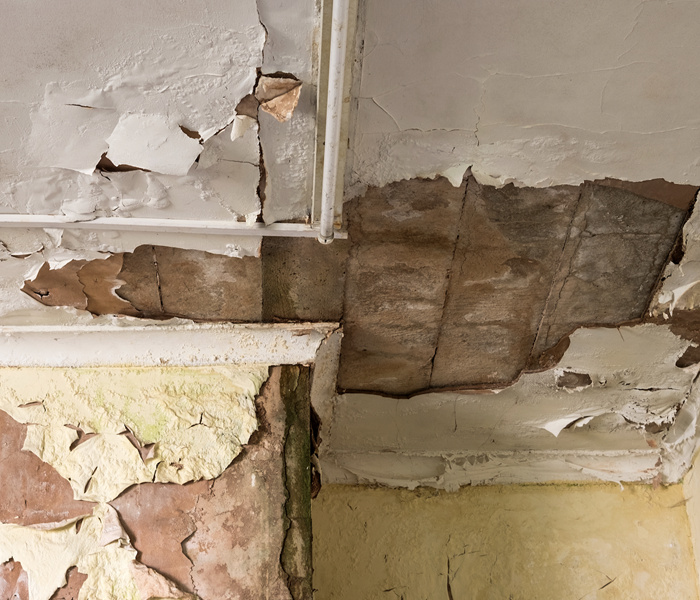 When humidity is high, water damage may be present. Call the professionals for quick response to safeguard your home or business.
When humidity is high, water damage may be present. Call the professionals for quick response to safeguard your home or business.
Texas, with its warm and humid climate, is no stranger to the challenges of water damage and mold growth. Understanding the connection between humidity and these issues is crucial for homeowners. In this blog, we'll explore how humidity levels can affect water damage and contribute to mold growth in Baytown, as well as strategies to mitigate these problems effectively.
The Role of Humidity in Water Damage
Baytown's high humidity levels can exacerbate water damage issues. Moisture from the air can prolong the drying process, making it harder to completely remove moisture from affected areas. This can lead to structural damage and the onset of mold growth.
Immediate Water Removal
In a humid environment, it's essential to act swiftly when water damage occurs. Promptly removing standing water and drying affected areas can prevent prolonged exposure to high humidity, reducing the risk of further damage.
Dehumidification
Utilizing dehumidifiers is an effective way to control indoor humidity levels. They can help maintain optimal moisture levels, making it less conducive for mold to thrive in your home.
Proper Ventilation
Good ventilation is key to managing humidity. Ensure that your home is adequately ventilated to allow moisture to escape. Use exhaust fans in areas prone to moisture, such as bathrooms and kitchens.
Sealing Leaks
Address any leaks in your home promptly. Leaks not only introduce moisture but also increase humidity levels. Fixing leaks can help maintain a drier indoor environment.
Regular Maintenance
Regularly maintaining your HVAC system can prevent moisture buildup. Clean or replace filters as needed to ensure efficient moisture control.
Monitoring Humidity Levels
Invest in a hygrometer to monitor indoor humidity levels. Keep them between 30% and 50% to create an environment less conducive to mold growth.
Mold Prevention
To prevent mold growth, address water damage immediately and thoroughly. Mold can begin to develop within 24-48 hours after water damage occurs.
Professional Mold Remediation
If you suspect mold growth or encounter a mold problem in Baytown, seek professional mold remediation services like SERVPRO®. They have the expertise and equipment to safely remove mold and prevent its return.
In Baytown, TX, where humidity is a constant factor, understanding the impact of humidity on water damage and mold growth is essential for homeowners. By taking proactive measures to control indoor humidity levels, promptly addressing water damage, and seeking professional help when needed, you can protect your home from the devastating effects of mold and ensure a healthier living environment for you and your family. For expert assistance with water damage restoration and mold remediation in Baytown, contact SERVPRO® today. We're here to help you safeguard your home.
Effective Emergency Storm Response Planning in Houston
9/26/2023 (Permalink)
Houston, TX, a city prone to severe weather events like hurricanes and heavy rainfall, requires homeowners and property owners to be well-prepared for emergencies. Developing a comprehensive emergency response plan is crucial for safeguarding lives, and properties, and ensuring a swift recovery. In this blog, we'll explore the importance of emergency response planning for storms in Houston and provide actionable steps to help you create an effective plan tailored to the region's unique challenges.
Understanding Houston's Storm Challenges
Houston faces a range of storm-related challenges, including hurricanes, tropical storms, heavy rainfall, and flooding. The city's flat terrain and complex drainage systems can exacerbate flooding, making proactive emergency response planning a necessity for residents.
Develop a Family or Business Emergency Plan
Whether you're a homeowner or a property owner, creating an emergency plan is essential. This plan should include communication strategies, evacuation routes, meeting points, and a list of emergency contacts. Assign specific responsibilities to family members or employees to ensure a coordinated response.
Stay Informed
Regularly monitor weather forecasts and alerts through local news, weather apps, and official sources like the National Weather Service. Understanding the timing and severity of incoming storms enables you to take timely action.
Designate Safe Areas
Identify safe areas within your property or building where you can seek shelter during a storm. These areas should be away from windows and doors, preferably in an interior room or hallway.
Protect Important Documents
Secure vital documents like insurance policies, identification, and property records in waterproof containers. In the event of property damage, having access to essential documents facilitates the recovery process.
Stock Up on Emergency Supplies
Prepare an emergency kit containing essential supplies such as non-perishable food, water, medications, first-aid items, flashlights, batteries, and personal hygiene products. Ensure the kit is easily accessible and periodically update its contents.
Secure Outdoor Items
Outdoor furniture, equipment, and decorations can become projectiles during storms. Anchor or store these items indoors to prevent them from causing damage or injury.
Implement Flood Preparedness Measures
Houston's vulnerability to flooding underscores the importance of flood preparedness. Elevate utilities, install flood barriers, and consider flood insurance to protect your property from water damage.
Communicate and Practice
Regularly review your emergency plan with family members, employees, or tenants. Conduct drills to practice evacuation procedures and ensure everyone is familiar with the plan's protocols.
Crafting a comprehensive emergency response plan tailored to the storm challenges in Houston, TX, is a critical step in safeguarding your loved ones and property. From developing a family or business emergency plan to staying informed, designating safe areas, protecting important documents, and stocking emergency supplies, these measures will help you navigate storm-related emergencies effectively. By taking proactive steps and staying prepared, you can mitigate risks, reduce potential damage, and ensure the safety of your home, family, and property during storms.
Water Damage Tips: Essential Steps to Minimize the Impact of Water Intrusion
8/10/2023 (Permalink)
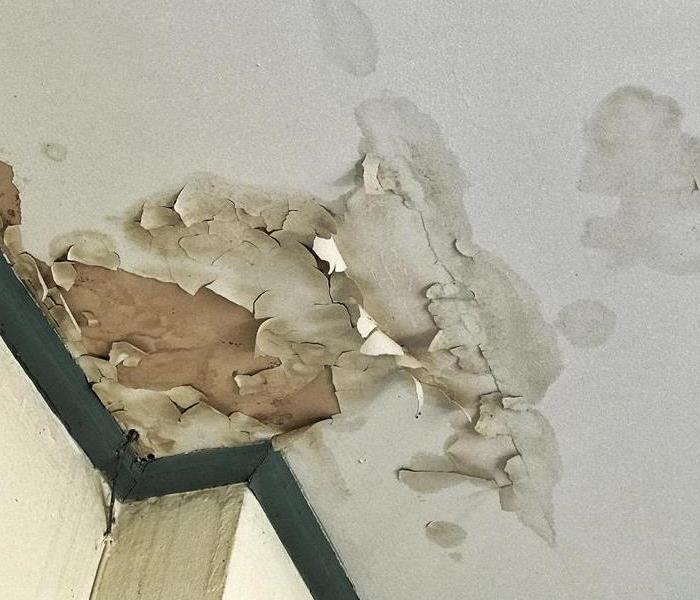 Water damage can be a challenging and stressful experience.
Water damage can be a challenging and stressful experience.
Water damage can strike unexpectedly and wreak havoc on your property, leading to costly repairs and damages. Whether caused by a burst pipe, flooding, or a leaky roof, taking immediate action is crucial to minimize the impact of water intrusion. In this blog, we will provide you with essential tips to help you handle water damage effectively and mitigate further harm to your home or business. By following these steps, you can navigate through this challenging situation with confidence and protect your property.
Prioritize Safety
Before entering a water-damaged area, ensure that it is safe to do so. Turn off the electricity to affected areas, especially if water levels are high or if electrical outlets or appliances are submerged. If necessary, seek professional assistance to safely assess and mitigate potential hazards.
Stop the Water Source
If the water damage is caused by a plumbing issue, such as a burst pipe or overflowing appliance, locate and shut off the main water supply to stop the flow of water. This immediate action will help prevent further damage and flooding.
Document the Damage
Take photos or videos of the water damage and affected areas as evidence for insurance claims. This documentation will assist in the assessment and compensation process. Make a detailed list of damaged items and their approximate value.
Remove Excess Water
Using mops, towels, or a wet/dry vacuum, remove as much standing water as possible. Promptly drying the affected area will help prevent the growth of mold and further structural damage. Open windows and use fans or dehumidifiers to enhance air circulation and aid in the drying process.
Salvage Valuables
If items are salvageable and not excessively damaged, remove them from the affected area and place them in a dry and well-ventilated space. Take immediate action to dry out important documents, electronics, and sentimental items.
Assess and Mitigate Mold Growth
Mold can start growing within 24-48 hours after water intrusion. Inspect the affected area for signs of mold growth and address it promptly. Remove any wet materials, such as carpets, furniture, or drywall, that cannot be adequately dried or cleaned. Consult with professionals if extensive mold remediation is required.
Contact Your Insurance Provider
Notify your insurance provider about the water damage as soon as possible. Familiarize yourself with your insurance policy coverage and follow their instructions regarding documentation, assessments, and repairs. Keep all receipts related to mitigation and restoration efforts.
Prevent Future Water Damage
Take preventative measures to reduce the risk of future water damage. Regularly inspect and maintain your plumbing system, roof, and gutters. Install water leak detection devices and consider adding flood-resistant barriers or sump pumps in flood-prone areas.
Consult with Restoration Specialists
If the water damage is extensive or if you are unsure of the best course of action, consult with water damage restoration specialists. They can provide expert guidance, comprehensive assessments, and professional services to restore your property to its pre-damaged condition.
Water damage can be a challenging and stressful experience, but by following these essential tips, you can minimize the impact and protect your property. Acting swiftly and effectively in response to water damage can make a significant difference in mitigating further harm and restoring your property to its previous state.
Fire Prevention Tips: Protecting Your Home and Loved Ones
8/3/2023 (Permalink)
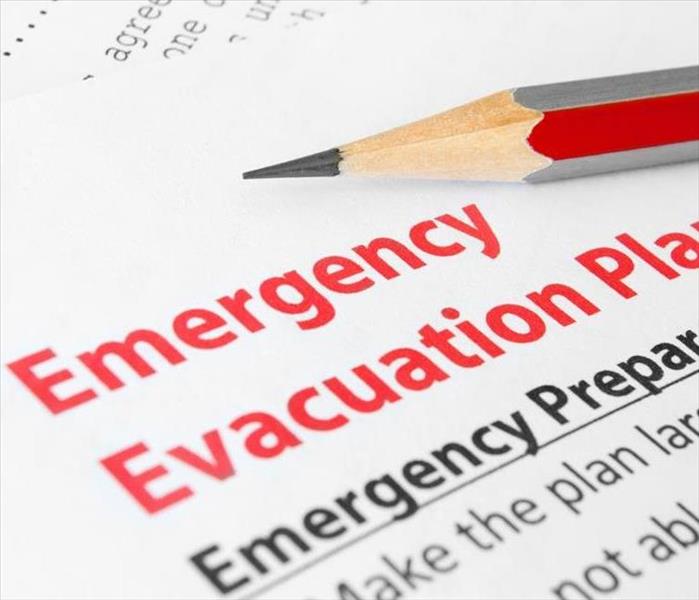 Having a fire prevention emergency plan in place to reduce the risk and protecting your home.
Having a fire prevention emergency plan in place to reduce the risk and protecting your home.
Fires can wreak havoc on our homes, causing damage and posing a serious threat to the safety of our loved ones. Fortunately, there are steps you can take to minimize the risk of fire and protect your home. In this blog post, we will provide you with essential fire prevention tips that can help you safeguard your living space and keep your family safe.
Install Smoke Detectors
Smoke detectors are crucial in alerting you to the presence of smoke and fire in your home. Install smoke detectors on each level of your house, including inside bedrooms and outside sleeping areas. Test them regularly and replace batteries as needed.
Develop a fire escape plan and practice it regularly with your family. Identify two ways to escape from each room and establish a meeting point outside. Make sure everyone in your household knows how to properly use windows, doors, and escape ladders if necessary.
Keep Fire Extinguishers Handy
Place fire extinguishers in key areas of your home, such as the kitchen, garage, and near fireplaces. Familiarize yourself with how to use them properly and ensure they are regularly inspected and maintained.
The kitchen is a common area where fires start. Practice safe cooking habits by never leaving cooking food unattended, and keep flammable items such as oven mitts, towels, and paper products away from the stove. Clean your oven and stove top regularly to prevent grease buildup.
Be Cautious with Candle
Candles can create a cozy atmosphere, but they can also be a fire hazard if not used carefully. Keep candles away from flammable materials and place them in sturdy holders on heat-resistant surfaces. Never leave candles unattended, and extinguish them before leaving the room or going to bed.
Store Flammable Materials Responsibly. Properly store flammable materials such as gasoline, cleaning supplies, and paints in well-ventilated areas away from heat sources. Follow the manufacturer's instructions for storage and disposal to prevent accidents.
Maintain Electrical Safety
Electrical malfunctions are a leading cause of house fires. Ensure that your home's electrical system is up to code and have any wiring issues addressed by a professional electrician. Avoid overloading outlets and extension cords, and never run cords under rugs or furniture.
If you smoke, make sure to extinguish cigarettes completely in designated ashtrays. Avoid smoking in bed or when drowsy, as a lit cigarette can easily start a fire if dropped or left unattended.
Use Space Heaters Safely
When using space heaters, keep them at least three feet away from any flammable materials, including curtains, furniture, and bedding. Never leave them unattended and ensure they are turned off before leaving the room or going to bed.
Regularly Maintain Heating Systems. Have your furnace, chimney, and HVAC system inspected and maintained by professionals regularly to ensure they are functioning properly and free from any potential fire hazards.
Educate Your Family
Teach your family about fire safety and the importance of following prevention measures. Show children how to safely use matches, lighters, and appliances, and stress the importance of reporting any fire hazards or concerns to an adult.
Incorporating these fire prevention tips into your daily routine can significantly reduce the risk of fire in your home. Stay vigilant, be proactive, and prioritize the safety of your loved ones. Remember, fire prevention is a collective effort and the responsibility rests on everyone's shoulders. By working together, we can protect our homes and prevent the devastating consequences of fire.





 24/7 Emergency Service
24/7 Emergency Service






